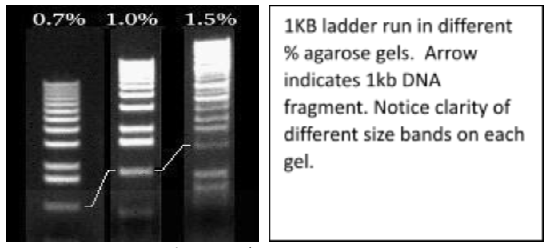Common Agarose Gel Related Questions and Tips
(http://www.lifetechnologies.com/us/en/home/life-science/pcr/elevate-pcr-research/agarose-content-with-tips-and-tricks.html#2)
1. What Percent Agarose is best?
The standard percentage of agarose used to run a DNA gel is usually around 1.0%. A higher agarose percentage enhances the resolution of smaller bands; conversely, a lower agarose percentage gives better resolution and separation of higher-molecular-weight bands. If the wrong percentage is used, it can be difficult to visualize the DNA bands reliably

|
% Gel
|
Optimum Resolution/ Linear DNA (kb)
|
|
0.5
|
30 to 1.0
|
|
0.75
|
12 to 0.8
|
|
1.0
|
10 to 0.5
|
|
1.2
|
7 to 0.4
|
|
1.5
|
3 to 0.2
|
*For very small parts, 2% gel may be an option. Talk to your instructor about it!*
2. How does gel casting affect the band resolution?
The recommended thickness for agarose gel is 3–4 mm; a gel thicker than 5mm will result in fuzzy bands and higher staining background. Similarly, the amount of running buffer to cover over the gel in an electrophoresis apparatus is 3–5 mm. Too much buffer will decrease DNA mobility and cause band distortion. The thickness of the comb is also important and significantly affects resolution. A thin comb (1 mm) gives very well-defined bands, while a thick comb gives thick bands leading to reduced resolution.
3. How much DNA to run (Less is best)
The minimal quantity of DNA that may be detected is dependent on the stains used. The maximum quantity of DNA in a band that is still clear and well-defined is approximately 100 ng.
4. What is the right buffer for your agarose gel electrophoresis?
The two most popular types of buffers for running agarose gels are Tris-acetate with EDTA (TAE) and Tris-borate with EDTA (TBE). For small DNA (<1000 bp), and if there is no plan to extract the DNA, then 1x TBE buffer is recommended. TBE buffer has a high ionic strength and buffering capacity. TAE buffer, together with low field strength (1–2 V/cm), is preferred for separating large DNA (12–15 kb). TAE buffer interacts with agarose, resulting in lower electroendosmosis, larger apparent pore size, and lower field strength compared to agarose gels in TBE buffer. Buffer must be added to the GEL.
5. Why do I see so many bands?
Uncut DNA will typically appear to run faster than fully linearized plasmids. Isolated, uncut plasmid should be in the supercoiled form. The use of restriction enzymes will linearize our plasmids.
(http://bitesizebio.com/13524/how-to-identify-supercoils-nicks-and-circles-in-plasmid-preps/)
How to identify supercoils, nicks and circles in plasmid preps


DNA Ladder (Quick-Load Purple 1kb Plus DNA Ladder, New England Biolabs)




